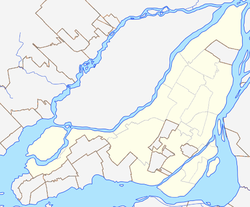Little Burgundy
|
Little Burgundy La Petite-Bourgogne |
|
|---|---|
| Neighbourhood | |

Edifice Georges Vanier
|
|
| Location of Little Burgundy in Montreal | |
| Coordinates: 45°29′07″N 73°34′33″W / 45.485209°N 73.575954°WCoordinates: 45°29′07″N 73°34′33″W / 45.485209°N 73.575954°W | |
| Country | Canada |
| Province | Quebec |
| City | Montreal |
| Borough | Le Sud-Ouest |
| Established | 1864 |
| Population (2011) | |
| • Total | 10,046 |
Little Burgundy (French: La Petite-Bourgogne) is a neighbourhood in the Sud-Ouest borough of the city of Montreal, Quebec, Canada.
Its approximate boundaries are Atwater Street to the west, Saint-Antoine to the north, Guy Street to the east, and the Lachine Canal to the south.
The adjacent neighbourhoods are the borough of Ville-Marie and downtown Montreal to the north and northeast, Griffintown to the southeast, Pointe-Saint-Charles to the south, and Saint-Henri to the west.
There are differing accounts of the origin of the name Little Burgundy (Petite-Bourgogne). A surveyor's map of 1855 identifies a property called Bourgogne, owned by the heirs of the Hon. Louis Guy (brother of Étienne Guy, for whom Guy Street was named). The property corresponds to the areas bounded today by Rue des Seigneurs, Rue Notre-Dame, Rue Saint-Martin, and Rue Saint-Antoine.
Essentially agricultural until 1810, today's Little Burgundy began to be built up the ward of St. Joseph, a faubourg spreading outside the city walls. The area around Richmond Square was built up in 1819.
Development accelerated in the mid-19th century with the construction of the Lachine Canal attracted many so-called "smokestack" industries, most notably the Canadian Pacific Railway yards, and the Steel Company of Canada (or Stelco) plant, among others. A residential sector was built north of the factories between 1857 and 1864. Originally part of the parish of Saint-Henri-des-Tanneries, it was set up as the village of Delisle in 1864, then Sainte-Cunégonde in 1876, becoming a town in 1884. The name derived from St. Cunigunde of Luxembourg, wife of St. Henry II, Holy Roman Emperor, a reference to the neighbouring parish.
...
Wikipedia

